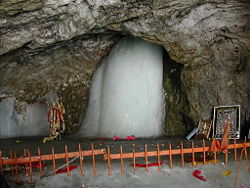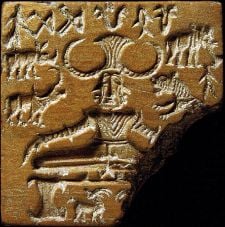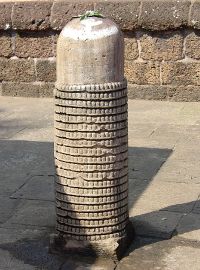Linga
 From Nwe
From Nwe 
The linga (also known as "Lingam") is the primary symbol of the Hindu god Shiva and the main cultic object of devotion in Shaivism (the school of Hinduism that worships Shiva as the supreme divine being). In Hindu devotional and ritual practice, the linga has four interrelated meanings and purposes: firstly, it symbolizes Shiva and his regenerative power as both the destroyer and reproducer of the universe; secondly, it represents the male reproductive organ and its seminal potentiality (and, paradoxically, ascetic restraint); thirdly, it provides the main object of cultic devotion in Shaivite temples containing upraised cylindrical shafts at the center of their sanctuaries. Finally, it is used as a mark, sign, and symbol of Shaivism, allowing one to identify with, and recognize, followers of this group.
In ritual practice, the linga is commonly found in proximity to a yoni (representing Shakti), the vulvular symbol of female creative energy. Although the linga is phallic in form, it is not worshiped merely in its anthropomorphic reference, nor is it exclusively a symbol of sexual potency. Instead, the linga connotes a deeper acknowledgment of Shiva's infinite creative power as it exists in juxtaposition with his chastity. The linga is considered the supreme representation of Shiva. Worship of the linga is most common in South India where Shaivism is prevalent, particularly among the Lingayats of Karnataka.
Origins
Historical

The earliest known objects resembling lingas have been found in the Indus Valley Civilization of ancient India. Archeological findings there include stone replicas of human phalluses approximately two feet in length, which are more explicitly phallic in shape than the linga as known today. Archaeologists have also found an engraved seal depicting an ithyphallic male figure with horns sitting in a yogic position. This image appears to represent a prototype of the Vedic deity Rudra, who would eventually evolve into Shiva. The connection between the phalluses and the early conception of Shiva suggests that the relationship between this god and the erect male member was an ancient aspect of worship.
The makers of these images were later displaced by the Aryans, with whom their religion was synthesized. In the Rgveda, Aryan invaders complained about the inhabitants of the Indus Valley "having the phallus as a god" (10.99). Ironically, by the first–second century C.E. it would become commonplace for these Aryans, who had formerly disapproved of the linga worship, to worship the very same symbol. However, by these later periods, the phallic realism of the linga was largely lost.

Linga worship had become very common by early Medieval India (approximately 700-1200 C.E.), during which time the Puranas had ascended to prominence in the popular religion. In particular, the Kurma Purana provided the specific blueprint for linga worship. Although the text was originally said to be narrated by Kurma, an Avatar of the preserver God Vishnu, the text was recast by the Pasupatas, a group of Shiva worshippers devoted to that god in his form as Pasupati, lord of creatures. They reworked the text to reflect their own views including directions worship of Shiva by way of the linga.
Mythological
The mythological origin of linga worship is recounted in the Kurma Purana, which describes a story of a group of ascetics living out their "forest-dweller" (Vanaprasta) stage of life to the Pine Forest (or devadaruvana) located in the Himalayas. The minds of these forest sages were intent on performing sacrifices prescribed in the Vedas so as to curry favor from the divine. However, Shiva intervened to test the sages, assuming the form of a well-muscled 19–year–old. It is said that another Hindu God, Vishnu, accompanied Shiva in the form of a beautiful young maiden.
Thereafter, the text recounts that Shiva made love to the sages' wives day and night for twelve years. Seeing these blasphemies, the sages chastised the incarnate Shiva, prohibiting him from participation in their austerities. Shiva steadfastly denied that there had been any wrongdoing, which further enraged the sages and they proceeded to assault him physically. Additionally, the sages demanded that Shiva remove his own linga, which had caused so much trouble among the sages and their wives. Shiva complied, ripping out his sexual organ. Suddenly, however, there "began strange portents, betokening danger to all worlds. The sun with its thousand rays did not shine. The earth began to tremble. All the planets lost their splendor, and the ocean roiled" (as quoted in Davis 2002, 155). Seeing this, the perplexed sages went to Brahma, the creator god, and recounted the events to him. Brahma pointed out the utter vainness of the sage's tribulations, noting that they had been entirely fooled by Shiva's maya. Brahma revealed to them that this young man who had removed his genitalia was in fact Shiva, the supreme lord, and proceeded to chastise the sages for their failure to recognize him. The sages immediately wanted to know how they could connect again with Shiva, so as to make amends for the castration they had forced upon him. Brahma offered them the following advice:
You should make a copy of the god's linga which you saw fall on the ground...and with your wives and sons attentively offer worship to that matchless linga, following Vedic rules only and observing celibacy. You should consecrate the linga using the mantras from the Rg, Yajur and Sama Vedas pertaining to Shiva. Then, following the highest ascetic regime and chanting the hundred names of Shiva, you, your sons, and you kinsmen should worship it intently (Davis 2002, 157).
Only by making a copy of the detached linga would the sages be able to petition Shiva. The sages then returned to the Pine Forest, now ready to recognize Shiva should he appear again, and they proceeded to worship Shiva using the linga.
The central motif of the story concerns the sages' acquisition of the ability to see beyond mere appearances of form to perceive true reality. Thus, the linga serves to represent this ability, which is absolutely necessary for the purposes of liberating the Atman, or soul. Should the men in the pine forest worship this image with baths, flowers and mantras, they will be worshiping Atman, perceiving simultaneously its phases as divine and human, thus allowing them to overcome attachment to birth or death. The cure for the ills of life is not to return to the original, most basic situation that is characterized by wild and erotic expressions of creativity, such as those which are predominant early in this story. Although this situation is important, it is one which must eventually be escaped. Isolated from the body and protruding from the earth, Shiva's castration became a symbol of chaste asceticism—a "pillar" of refusal to undertake creative action.
Another important myth involving the linga, recorded in Shiva Purana 2.1.6-9, describes an argument between Shiva's counterparts in the Trimurti, Brahma and Vishnu, over which of them was the supreme creator god. They were interrupted when Shiva appeared in the form of a brilliant column of light. With the identity of the pillar unbeknownst to them, Brahma and Vishnu came to an agreement that the first one who could scale the entirety of this column should indisputably be the supreme divinity. Vishnu took form of a boar so that he could dig under the column, while Brahma assumed the form of a goose so that he could fly to the top. The further each god searched in its respective direction, the further the column stretched. When Brahma and Vishnu finally realized the futility of their quest, the light revealed itself to be Shiva in the form of the linga. This linga is also known as the jyotir-linga, the pillar of endless light representing the ultimate form by which Shiva manifests himself.
Worship

The linga is the main object of cultic devotion in Shaivism (Hindu sect devoted to Shiva), serving as the focal point of worship in both temples and family shrines throughout India. Worship of the linga is performed with offerings of fresh flowers, water, sprouts of grass, fruits, leaves and sun-dried rice. The unblemished purity of all materials given to the linga is always of the utmost importance to the worshipers making offerings.
Lingas used in worship are of two varieties: those made by humans and those that occur naturally. While various canonical guidelines for the construction of linga provide sculptors with specific rules prescribing ideal height, width, and curvature of the linga, in reality lingas range from very small to very large. Smaller, disposable lingas are typically made of sandal paste or river clay, while larger lingas are often forged from wood or metal, and in some instances, precious stones. The yoni, a representation of the vulva imbued with comparable symbolic value, often provides the base for the erect linga. Lingas formed in nature, meanwhile, are considered to be the among the most important, since Shaivites believe these monuments were self-created at the beginning of time. Nearly 70 of these naturally occurring lingas, or Swayambhu, are worshiped in the various parts of India in which they are located. The natural black stone, eight feet in diameter, which appears at Lingaraj temple at Bhubaneswar in Madras, is one such Swayambhu.
Worship of the linga is used to acknowledge Shiva more frequently than anthropomorphic images of the God. However, not all lingas are devoid of anthropomorphic traits. On some linga, a human head has been sculpted or adhered to the cylinder, or, in other cases, four heads are positioned in each of the cardinal directions, with a fifth head implied on the top. These are classified as mukhalinga.
Symbolism
The linga is considered to be the most complete representation of the all-powerful, all-knowing essence of Shiva. Fittingly, the linga is worshiped as an emblem of generative power, not only that of the supreme divine but also that which is present in the phenomenal world. The linga symbolizes creativity on multiple levels: biological, psychological, and cosmic, acknowledging the creative seed that has spawned and will continue to spawn the various aspects of material reality. Meanwhile, the linga also connotes the idea that this infinite creative power can also be restrained, transmuted and absorbed within the yogin just as it is within Shiva, the lord of all yogins. The yoni, as the base of the erect linga, serves as a reminder that the male and female principles are ultimately inseparable. When put together, their collective creativity represents the totality of existence.
The linga is sometimes also included in anthropomorphic images of Shiva, rendered here as a more realistic sexual organ attached to the body of the god. Shiva, along with his linga, is said to be creator and destroyer of the universe, thus his ithyphallic depiction symbolizes his immense creativity. However, Shiva is traditionally said to be celibate, and it is in this dissolution of opposites that the linga attains its immense symbolic value. This ever-erect, never-wilting phallus seems to suggest Shiva's status as the ideal renunciate: one able to control the processes of the body without forfeiting the power of its creative potency.
Lingayats
While the linga is a symbol of great importance to all Shaivite sects, it is the central object of all spiritual activity for one in particular—the Lingayats ("bearers of the linga"), also known as the Virasaivas ("heroic Shaivas"), a reformist Shaivite sect prominent in the border regions of Maharashtra and Karnataka in the mid-twelfth century. For them, the linga represents the most important religious symbol. Legend has it that a Brahmin named Basava or Basavanna (1106-1167), founder of the sect, was a devotee of Shiva, worshiping the god exclusively in temples. Basava quickly gave up this practice when a dream instructed him to leave his hometown and serve a distant king. Having been banished from his preferred temple, Basava cried out against Shiva's cruelty. However, the very next night, Shiva appeared from the mouth of a sacred bull bearing a linga, which he gave to Basava. With this token, Shiva now accompanied Basava at all places and times, and the Brahmin was set free from his previous state of dependence upon worship in the temple.
Followers promptly collected around Basava, enchanted by his rejection of religious formalities such as temple worship and Brahmanic domination. No longer did they accept divisions based on sex or caste, nor did they accept remarriage of widows or marriage of young children. Following their leader, each of Basava's disciples wore a linga in a tube fastened to their neck (or to their arm), which took the place of the sacred thread worn by most orthodox upper caste Hindu men. Lingayats continue this practice to this day. Otherwise, Lingayats are highly iconoclastic, and the linga is the only symbol they are permitted to acknowledge, since it alone serves as a constant reminder to the devotee that no other focus is necessary. Loss of this linga is considered to be equivalent to spiritual death. Although the group condemns virtually all rituals, they still have several rites of their own, one of which states that they must pay homage to the linga they wear at least twice a day. The sect now has a sizable number of adherents in Karnataka, though they are largely considered "archaic" by mainstream Shaivites.
References
ISBN links support NWE through referral fees
- Bowker, John. 2002. God: A Brief History. New York: DK Publishing. ISBN 0789480506
- Davis, Richard H. 2002. "The Origin of Linga Worship" in Religions of Asia in Practice. edited by David S. Lopez. Princeton NJ: Princeton University Press. ISBN 0691090602
- Eliade, Mircea (ed.). 1986. Encyclopedia of Religion. New York: MacMillan Publishing, 1987. ISBN 978-0029098509
- Gupta, Anand Swarup, (ed.). 1971. The Kurma Purana. Varanasi: All India Kashiraj Trust.
Credits
This article began as an original work prepared for New World Encyclopedia and is provided to the public according to the terms of the New World Encyclopedia:Creative Commons CC-by-sa 3.0 License (CC-by-sa), which may be used and disseminated with proper attribution. Any changes made to the original text since then create a derivative work which is also CC-by-sa licensed. To cite this article click here for a list of acceptable citing formats.
Note: Some restrictions may apply to use of individual images which are separately licensed.↧ Download as ZWI file | Last modified: 02/04/2023 09:55:24 | 12 views
☰ Source: https://www.newworldencyclopedia.org/entry/Linga | License: CC BY-SA 3.0
 ZWI signed:
ZWI signed: KSF
KSF